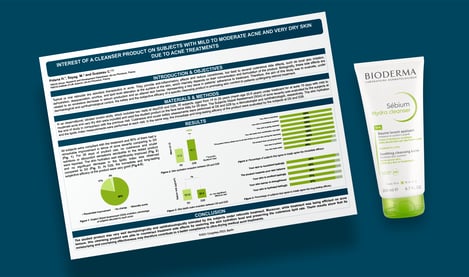6 professionals
Benefits of a gel cream in atopic dermatitis through lipids replenishing and reducing itching
Benefits of a gel cream in atopic dermatitis through lipids replenishing and reducing itching
Mélanie Come1, Elise Abric1, Sandrine Bergera-Virassamynaïk1, Christelle Graizeau1,2, Nathalie Ardiet1 and Michèle Sayag1
1 NAOS Group, Research and Development Department, Aix-en-Provence, France
2 NAOS Institute of Life Science, Aix-en-Provence, France
Related topics
Atopic dermatitis (AD) is a complex, chronic relapsing skin condition. It frequently manifests in erythema and xerosis, goes along with pruritus, desquamation, and sleep loss contributing to reduced quality of life (QoL). The present abstract reports results from 3 different clinical studies that assessed the lipids replenishing, hydrating, anti-itching and clinical benefit of a novel gel cream containing an enoxolone derivative that soothes the skin, reduces inflammation and itching, as well as vitamin B3 that helps to restore the natural skin barrier, and which improves its tonicity and radiance in subjects with AD.
Two open-labelled, intraindividual clinical studies in healthy volunteers and one prospective, observational study in AD subjects were conducted. The first study assessed the lipids replenishing and hydrating effect of the gel cream using confocal micro-spectroscopy Raman and corneometry in 12 subjects with dry or very dry skin and who applied on one of the forearms the gel cream for 28 days. The 2nd study assessed its anti-itching benefit in 22 adult subjects with dry or very dry skin and an itching score ≥4 (from 0=none to 10=very severe) on designated areas of the face and body after 21 days. The third study assessed the clinical benefit, local tolerance, quality of life (QoL) and user perception of the gel cream after 28 days of use during summer season in 161 AD subjects aged above 3 months presenting a xerosis score ≥4 (from 0=none to 10=very severe).
After 28 days, thickness and hydration of the stratum corneum of the treated forearm had increased by 21% and 17%, respectively (p<0.05) compared to the control forearm; so did the lipid-protein ratio (5% increase, p=0.001). Corneometry confirmed the increase in skin hydration (15%).
The itching score decreased by 18% immediately after the 1st application as reported by 86% of the subjects; 24h after, the decrease was 46% as reported by 91% of the subjects. After 21 days of application of the gel cream, the decrease was 70% as reported by 95% of the subjects. All changes were statistically significant (p<0.001).
In total, 81% of the children, 72% of the adults and 78% of the global study population had their skin dryness significantly (p<0.001) improved with the gel cream after 28 days. Functional signs including desquamation, roughness, feeling of dryness, tightness, itching and sleep disturbance had significantly (p<0.001) improved in all populations; so did QoL. Subjects highly appreciated the efficacy and cosmetic properties of the gel cream.
Moreover, the gel cream was very well tolerated.
The gel cream significantly relipidates and hydrates the skin, and reduces itching and dryness in subjects with AD. Subjects highly appreciated the efficacy and cosmetic properties of the product which was very well tolerated.
Mélanie Come1, Elise Abric1, Sandrine Bergera-Virassamynaïk1, Christelle Graizeau1,2, Nathalie Ardiet1 and Michèle Sayag1
1 NAOS Group, Research and Development Department, Aix-en-Provence, France
2 NAOS Institute of Life Science, Aix-en-Provence, France


Interest of a cleanser product on subjects with mild to moderate acne and very dry skin due to acne treatments
Create easily your professional account
I create my accountGet access to exclusive dermatological services to increase your professionnal knowledge: +500 pathology visuals, clinical cases, expert videos
Benefit from valuable features: audio listening, materials to be shared with your patients
Stay informed about the upcoming events and webinars, latest scientific publications and product innovations